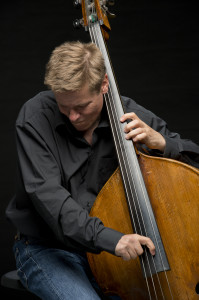 Peter Vuust is Professor at Royal Academy of Music, Aarhus and associate Professor at Center of Functionally Integrative Neuroscience, Aarhus University
Peter Vuust is Professor at Royal Academy of Music, Aarhus and associate Professor at Center of Functionally Integrative Neuroscience, Aarhus University
Neural processing of polyrhythmic structures in music
Ph.D. Thesis, 2006
Peter Vuust, M.Sc
SUMMARY
Peter Vuust’s Ph.D. thesis consists of 3 papers and a review in English. It represents research undertaken during his appointment partly as a research assistant at Centre of Functionally Integrative Neuroscience (CFIN), University of Aarhus, Denmark, partly as associate professor at Royal Academy of Music, Aarhus, Denmark (DJM). MEG measurements were conducted at BioMag Laboratory, Helsinki Brain Research Centre, Helsinki University Central Hospital, Finland.
Musicians, especially in improvisational music, often use complex rhythms such as polyrhythms when communicating during musical performances. Polyrhythms can roughly be divided into two types: 1) metric displacement (MD) and 2) regrouping of subdivisions (RS). In jazz improvisation, MD often appears as part of the initial phases, where connections between musicians have to be established, whereas RS typically emerges later in the communicational process intensifying the tension during more substantial parts of the improvisational climaxes. Using brain imaging technology, we wanted to study whether communication through polyrhythm in music is comparable to other forms of human communication, especially language, and if musicians perceive music as a language more than do non-musicians.
Using MEG, we investigated neural responses to metric incongruence (including MD) in musicians and non-musicians. In a separate experiment, we used fMRI to investigate neural correlates in musicians to epochs of intensive polyrhythm (RS) compared with epochs of no rhythmic tension.
We hypothesized that 1) neural processing of metric incongruence differ in lateralization and strength between musicians and non-musicians even at the pre-attentive level 2) processing of metric incongruence may be interpreted in a predictive coding framework, 3) processing of polyrhythm overlaps with certain aspects of language processing.
In the MEG study, we found that at pre-attentive level (reflected in the MMNm component) the incongruent rhythms, strongly and rapidly stimulated the left hemisphere of expert musicians. In contrast, rhythmically inept non-musicians responded with protracted dipole latency in the left hemisphere and a significant right hemispheric lateralization both indicating pre-dominant processing of incongruent rhythm in the right hemisphere. Interestingly, the P3am did not appear to be lateralized differently between groups but to be significantly stronger in expert musicians compared to rhythmically inept non-musicians.
We interpret the processing of relevant rhythm in the left hemisphere as a functional adaptation of the brains of expert musicians to rhythmic cues in music, which suggests that pre-attentive, left-lateralized processing of significant features of a message, be that phonemes or rhythmic and metric patterns, is a feature of highly developed competence in both music and language.
In addition we argue that the theory of predictive coding as most recently stated by Karl Friston offers a framework that may describe the functional integration involved in musical processing. We take the differential neural response of the MMNm and the P3am as evidence for a neural network involved in processing rhythmic incongruence, supporting the predictive coding theory.
In the fMRI study, we found that polyrhythms (RS) activated Brodmann area 47 bilaterally when musicians tapped the main pulse in a polymetric context where the music emphasized a counter pulse. Keeping the rhythm while listening to music, is fundamental to experiencing musical tension in different layers of the musical structure such that the music appears as a coherent meaningful expression. BA47 has consistently been implicated in studies of semantic processing. Thus similar cognitive processes and strategies may serve music, language and possibly other forms of communication.
The activation of BA47 in the right hemisphere correlated negatively with the metrical competence of the subjects as measured by their tapping standard deviation while keeping the rhythm during the counter meter. In contrast the difference between the left and right hemispheric response correlated positively (although non-significantly) with metrical competence. This supports the observations using MEG demonstrating competence related left lateralized brain responses to metric deviation. It extends the previous findings of competence induced left lateralization of rhythm/meter of pre-attentive processing in the auditory cortex to probably higher processing in the inferior frontal sulcus.
Taken together these studies suggest that processes fundamental to human communication subserve processing both of music and language. Furthermore certain processes of especially rhythm and meter in skilled musicians are lateralized to the language hemisphere. We propose that to musicians, rhythm is a language.
Se more @ http://www.petervuust.dk/